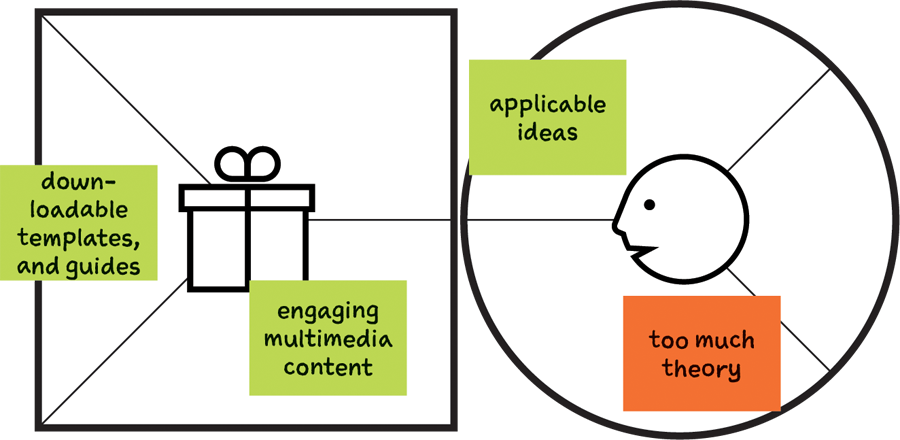4: Evolve

Measure and Monitor
Use the Value Proposition and Business Model Canvases to create and monitorspan performance indicators once your value proposition is operational in the market. Track the performance of your business model, your value proposition, and your customers’ satisfaction.
 |  |  |

![]()
Improve Relentlessly
Use the same tools and processes from testing and monitoring to improve your value proposition once it’s in the market. Continuously test “what if” improvement scenarios, and measure their impact on customer satisfaction.
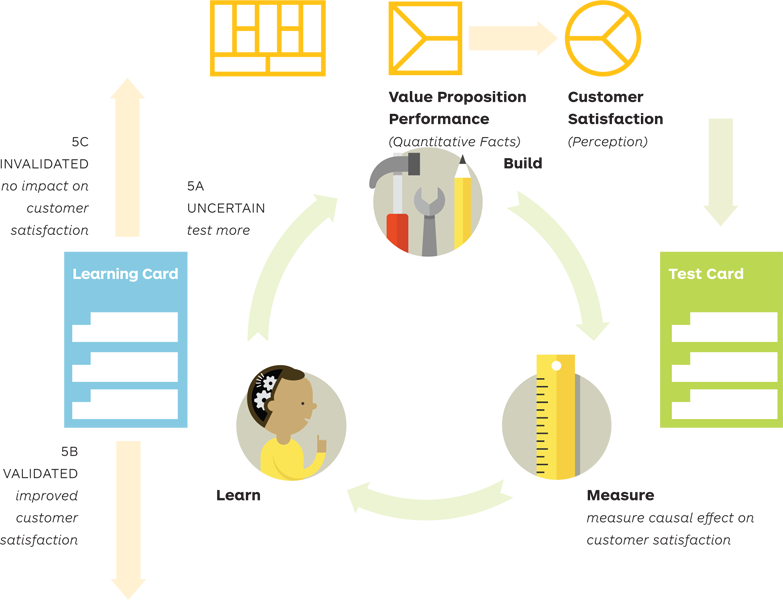



![]()
Reinvent Yourself Constantly
Successful companies create value propositions that sell embedded in business models that work. Outstanding companies do so continuously. They create new value propositions and business models while they are successful.
Today’s enterprise must be agile and develop what Columbia Business School Professor Rita McGrath calls transient advantages in her book The End of Competitive Advantage. She argues that companies must develop the ability to rapidly and continuously address new opportunities, rather than search for increasingly unsustainable long-term competitive advantages.
Use the tools and processes of Value Proposition Design to continuously reinvent yourself and create new value propositions embedded in great business models.
Five things to remember when you build transient advantages:
- Take the exploration of new value propositions and business models just as seriously as the execution of existing ones.
- Invest in continuously experimenting with new value propositions and business models rather than making big bold uncertain bets.
- Reinvent yourself while you are successful; don’t wait for a crisis to force you to.
- See new ideas and opportunities as a means to energize and mobilize employees and customers rather than a risky endeavor.
- Use customer experiments as a yardstick to judge new ideas and opportunities rather than the opinions of managers, strategists, or experts.
Continuously ask yourself…


What elements in your environment are changing? What do market, technology, regulatory, macroeconomic, or competitive changes mean for your value propositions and business models? Do those changes offer an opportunity to explore new possibilities or could they be a threat that might disrupt you?

Is your business model expiring? Do you need to add new resources or activities? Do the existing ones offer an opportunity to expand your business model? Could you bolster your existing business model or should you build completely new ones? Is your business model portfolio fit for the future?

Is your value proposition still compelling to your customers? How are your customer’s jobs, pains, and gains evolving? Can you build on your existing value proposition or do you need to revisit it entirely? Is there a new potential customer or a new segmentation emerging? What is happening in your business that creates the basis for new value propositions to existing or new customers?
![]()
Taobao: Reinventing (E-)Commerce
Taobao is the Chinese e-commerce phenomenon, part of the Alibaba Group. It is credited with ushering in a new wave of commerce in China by using the Internet to create an ecosystem where trusted commercial exchanges could take place. In 10 years it evolved its business models three times. It proactively embraced the changes taking place on its platform and in the wider Chinese economy and turned them into an opportunity.


1
Obstacles to commerce in the Chinese economy
Lack of infrastructure to do business
Consumers discouraged by high prices, low quality, and lack of trust.

2
Creation of a trusted platform
Launch of a payment and logistics infrastructure with partners to facilitate commercial transactions and shipment of goods.
Creation of a new value proposition for buyers and sellers
Introduction of a review system creates trust among buyers and sellers that did not exist in the physical economy
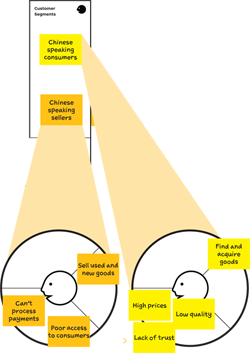
2006
Taobao — Small Business-to-Consumer (B2C)

1
Birth of microentrepreneurs
The Taobao platform becomes so popular that millions of sellers see an opportunity to become micro-entrepreneurs
Creation of the “Taobao University” to help entrepreneurs navigate the platform and learn about business
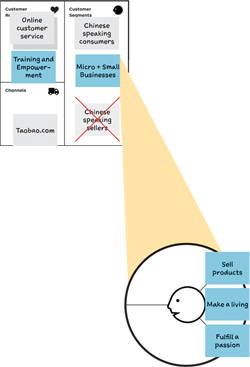
2
Pivot toward microentrepreneurs
Taobao shifts focus and builds on this trend by catering to micro-entrepreneurs
Inclusion of third-party service providers to strengthen the value proposition
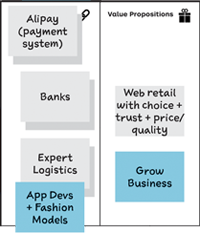
2008
Taobao — Big Business-to-Consumer (B2C)

1
A new asset is revealed
Taobao realizes that its business model possesses an incredible asset: hundreds of millions of Chinese consumers.
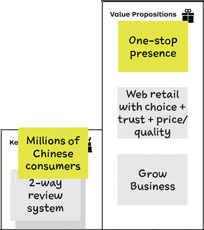
2
Launch of a new business
The “new” asset becomes the basis of a new value proposition
…for a new customer (big brands)…
…helping them reach Chinese consumers much faster than through the opening of physical stores.
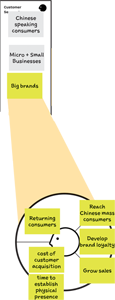
2013
Taobao — ?

Taobao went from a simple e-commerce platform to complex ecosystem in 10 years. It achieved this by improving and reinventing its value propositions and business models on the way. With new developments in mobile, gaming, messaging, and more, however, the company can’t rest on its laurels. Taobao is constantly challenged to continue its evolution.
![]()
Lessons Learned
Create Alignment
The Value Proposition and Business Model Canvases are excellent alignment tools. Use them as a shared language to create better collaboration across the different parts of your organization. Help every stakeholder understand how exactly you intend to create value for your customers and your business.
Measure, Monitor, Improve
Track the performance of your value propositions over time to make sure you continue to create customer value while market conditions change. Use the same tools and processes to improve your value propositions, which you used to design them.
Reinvent While Successful
Don’t wait with reinventing your value propositions and business models. Do so before before market conditions force you to, because it might be too late. Create organizational structures that allow you to improve existing value propositions and business models and invent new ones at the same time.
